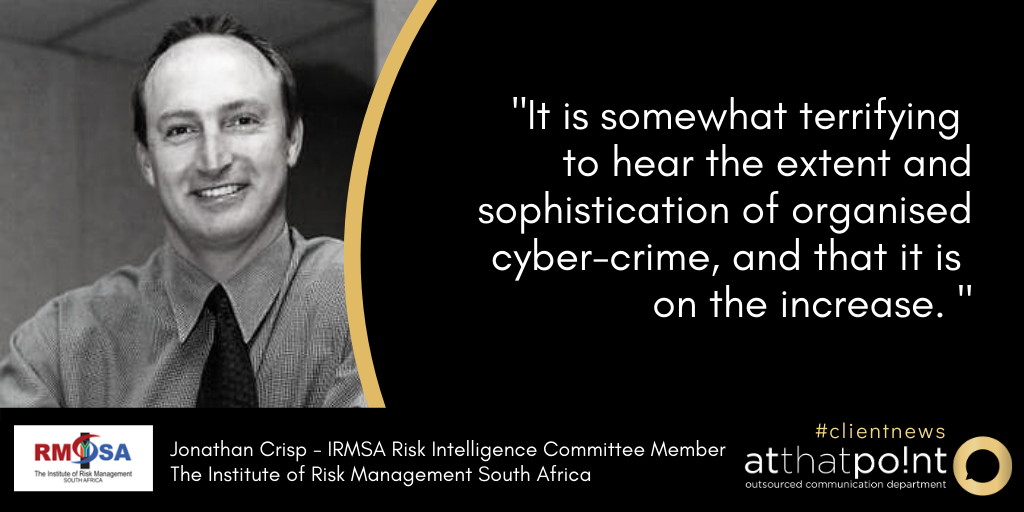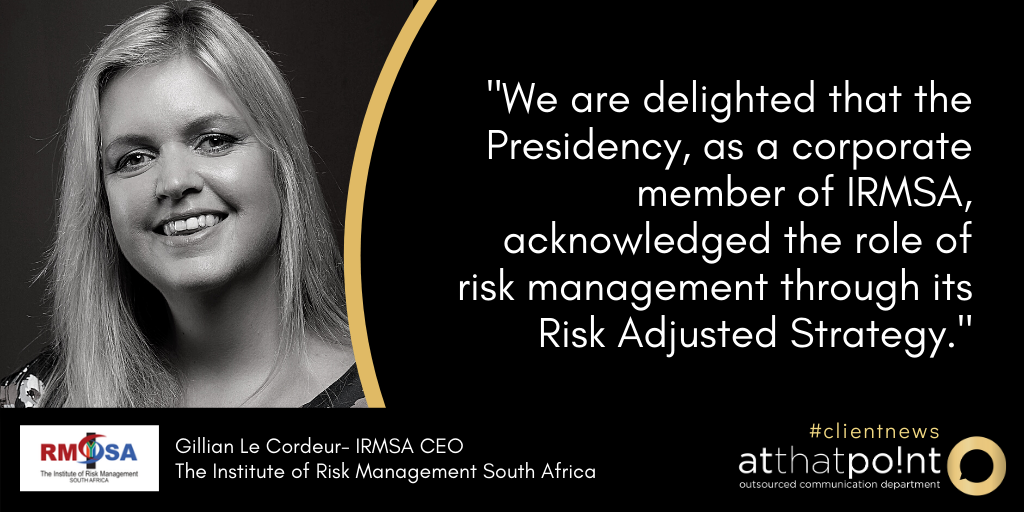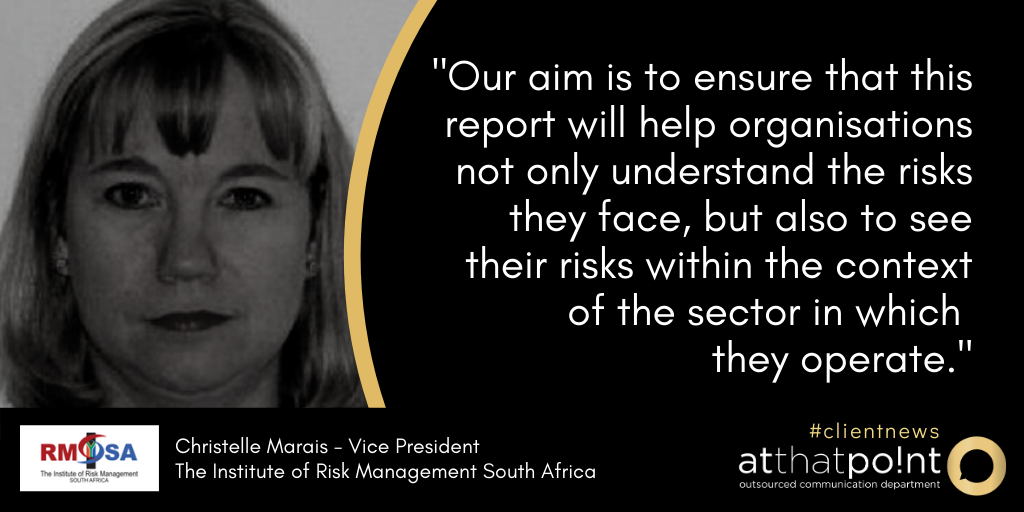|
Authored by: Jonathan Crisp, Risk Intelligence Committee Member at The Institute of Risk Management South Africa
In speaking to Junaid Amra, head of the Forensics Technology Solutions division at PwC, it is somewhat terrifying to hear the extent and sophistication of organised cyber-crime, and that it is on the increase. This, at a time when the world is reeling from the effects of COVID-19. PwC has various business units within their forensics technology division ranging from eDiscovery, search and seizure operations, data analytics, threat intelligence (which includes the monitoring of social media and the underground dark web) and an incident response team. A shocking fact is that at the time COVID-19 struck, medical facilities were targeted aggressively by cyber criminals. One of the first recorded incidents was a medical facility in Prague where cyber criminals targeted a COVID-19 testing centre and disrupted operations. What was interesting however, is that as cyber criminals and all their loved ones fell ill, the conversations on the dark web changed to being unacceptable to target medical facilities; so the demand for stolen medical data dropped as certain sites refused to publish the information and holding medical care facilities ransom decreased significantly. Cyber threats can be categorised as follows:
In our own country, cyber hacking of high profile politically exposed individuals remains a huge threat. Imagine how advantageous it is for corrupt individuals files to just disappear or be amended ‘appropriately’. At a time when our country is being sunk by the corruption of unscrupulous individuals, now more than ever we as civil society require justice and transparency, which requires the protection of and integrity of our state systems and information.
This was based on leaked information posted by attackers. These sectors are easier targets compared to the financial sector since they traditionally do not invest as heavily in cyber security as the financial sector. As result of COVID-19, there has been less demand for stolen credit card details due to the slowdown in international travel. PwC recently analysed the top 250 emerging technologies and have come out with a list of 8 technologies that they believe will be the most transformative to organisations in the next 3 to 5 years. The 8 transformative technologies are:
In summary, the convergence and timing of the following events, if not managed effectively, may contribute to a ‘perfect storm’ and destroy an organisation:
MEDIA CONTACT: Rosa-Mari, 060 995 6277, [email protected], www.atthatpoint.co.za For more information on IRMSA please visit: Website: https://www.irmsa.org.za/ Twitter: https://twitter.com/IRMSAInsight Facebook: https://www.facebook.com/IRMSAInsight/?ref=hl LinkedIn: https://www.linkedin.com/company/irmsa-institute-of-risk-management-sa/
0 Comments
President Cyril Ramaphosa, as chair of the National Command Council established under the Disaster Management Act, will tonight be honoured by the Institute of Risk Management South Africa (IRMSA) for the impact the Risk Adjusted Strategy had on responding to the enormous risks posed by the Covid-19 pandemic on the country and its people.
Jackson Mthembu, Minister in the Presidency, will accept the Risk Influencer of the Year Award on behalf of Pres Ramaphosa during the annual virtual awards ceremony. Broader recognition IRMSA introduced the Risk Influencer of the Year Award three years ago in recognition of individuals or organisations in business or government who are not risk professionals, says Gillian Le Cordeur, CEO of The Institute of Risk Management South Africa. “However, their understanding of the importance of risk management impacts directly on the work that we as risk professionals do. It elevates the role of the institute and the importance of effective risk management.” Throughout the year the IRMSA board considers any individual or organisation that has influenced or impacted business or society through their leadership role and the promoting of the value and importance of risk management. Unanimous decision The Risk Adjusted Strategy implemented by the President and his council received the unanimous vote from the IRMSA Executive Committee. The strategy has made the biggest impact during an extraordinary moment in our country, says Le Cordeur. The strategy considered the impact of the coronavirus and developed measures in which business, the economy and individuals could navigate the risks associated with the coronavirus. Elevate communication The institute was able to elevate its communication and advice with government on the risks posed by the virus. “We are delighted with the fact that the Presidency, as a corporate member of IRMSA, acknowledged the role of risk management through its Risk Adjusted Strategy and the role risk management plays, whether it is a pandemic or a process or any other risk facing the country,” says Le Cordeur. Previous winners Since the inception of the award prominent leaders such as Clem Sunter, South Africa’s most highly regarded scenario planner and strategist, received the award for integrating risk management into his approach to scenario planning and actively involving and supporting the risk profession in that regard. The King Committee received the award for the King IV Code that highlighted the role of risk management in governance. Last year the Risk Influencer of the Year went to Chief Justice Mogoeng Mogoeng, for his active role in promoting the importance of risk management for South Africa ensuring that we respond to the right opportunities, highlighting new risks as they emerge whilst managing those that already exist. Also, for putting those significant risks our country faces in the spotlight. Risks like greed, corruption, climate change, leadership and crime, to name a few. ENDS MEDIA CONTACT: Rosa-Mari, 060 995 6277, [email protected], www.atthatpoint.co.za For more information on IRMSA please visit: Website: https://www.irmsa.org.za/ Twitter: https://twitter.com/IRMSAInsight Facebook: https://www.facebook.com/IRMSAInsight/?ref=hl LinkedIn: https://www.linkedin.com/company/irmsa-institute-of-risk-management-sa/ The Institute of Risk Management South Africa (IRMSA) says that its annual Risk Report, due to be launched in February 2021, will be one of its most important yet.
Published annually, IRMSA’s Risk Report is widely seen as the definitive examination of the risks faced by South Africa and the organisations that operate within its borders. Christelle Marais, Vice President of IRMSA and the Chair of the Risk Intelligence Committee, says that the 2021 report will focus on lessons learned from the COVID-19 crisis for the risk management discipline. “Most organisations had a pervasive risks such as a pandemic on their risk registers, but few, if any, anticipated the real extent of the risk it actually posed,” she explains. “Because the world is so interconnected, the real issue is not the pandemic risk as such, but rather similar risks that could materialise in an equally far-reaching manner. Our risk report strives to answer the question: What do we as a country and as individual organisations need to be doing to deal with systemic risks of this scale?” Last year, IRMSA introduced some major methodological changes to its report, designed to make it more useful to risk decision-makers outside of the risk management discipline and to address the concerns of CFOs and COOs more directly. This approach will be continued this year, with the JSE assisting IRMSA to connect with decision-makers in the private sector; a wide range of public-sector decision-makers will also be included. “Our aim is to ensure that this report will help organisations not only understand the risks they face, but also to see their risks within the context of the sector in which they operate and the national and global socio-economic contexts, as well,” Ms Marais says. The 2021 report will be divided into five sections that take readers on a journey. Section 1 will incorporate insights from top South African leaders in the private and public sectors, small-medium enterprises and non-profits. Section 2 will examine the scenarios that South Africa is facing, and will provide a discussion about systemic thinking and risk appetite. Section 3 will then examine each of the identified risks in detail. While some of these risks will naturally have been carried over from last year, new ones will also feature—for example, the risk that COVID-19 has changed consumer behaviour for good. In the final two sections, the report will identify the competencies that South Africa as a country as well as South African organisations will need to succeed. Qualitative input will be sourced from C-Suite leaders via a survey, and highly specialised qualitative analysis will be used to generate useful insights. The report will culminate in a call to action for all to collaborate as we build a risk resilient country. “Each time a risk materialises, we learn more about what risks means in a world that’s increasingly complex,” Ms Marais concludes. “The IRMSA Risk Report is required reading in a world that is increasingly uncertain and in which the effects of risk are increasingly difficult to predict.” ENDS MEDIA CONTACT: Rosa-Mari, 060 995 6277, [email protected], www.atthatpoint.co.za For more information on IRMSA please visit: Website: https://www.irmsa.org.za/ Twitter: https://twitter.com/IRMSAInsight Facebook: https://www.facebook.com/IRMSAInsight/?ref=hl LinkedIn: https://www.linkedin.com/company/irmsa-institute-of-risk-management-sa/ |
Welcome to the IRMSA Newsroom
Archives
December 2020
Categories
All
|




 RSS Feed
RSS Feed